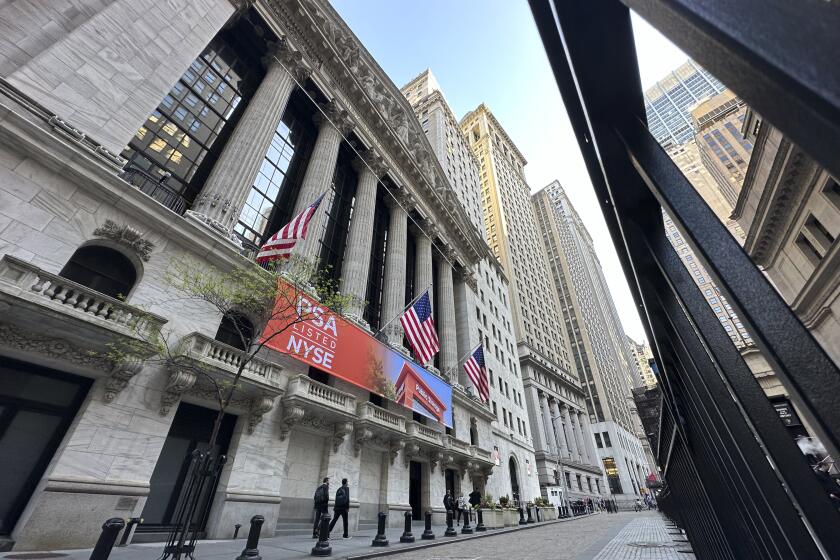Fewer foreclosures initiated in California in second quarter
Foreclosures were down in California during the second quarter of this year, but the drop represents an eye in the foreclosure storm that’s likely to continue in full force this year, a real estate research firm reported Wednesday.
The number of homes repossessed by lenders was down 28% from April through June compared with a year earlier, according to San Diego-based MDA DataQuick. Still, more Californians defaulted on their home loans. Default notices, which are sent to borrowers who miss several payments, were up 2% during the quarter from the previous year.
The growing number of mortgage defaults will almost certainly lead to more foreclosures this year. Lenders had postponed foreclosures to comply with government-imposed freezes and their own voluntary attempts to modify loans rather than repossess homes.
Now, banks “need to get serious about processing the backlog of delinquencies, either with workouts or foreclosure,” DataQuick President John Walsh said. “We’re hearing that some lenders and servicers are doing just that, hiring more people to do the necessary paperwork. That means the foreclosure numbers will probably shoot back up during the third quarter.”
Rising unemployment is also likely to drive future foreclosures, economists say.
Lenders in the second quarter sent out 124,562 default notices. That total was down 8% from the prior quarter’s record 135,431 default notices, but still higher than the 121,673 in the second quarter of 2008, DataQuick reported.
Home repossessions totaled 45,667 during the quarter. That’s up 5% from 43,620 in the previous three months but down from 63,316 a year earlier.
The largest servicer of mortgages in the nation, Bank of America Corp., estimates its foreclosure sales could rise 30%. Bank of America spokeswoman Jumana Bauwens said the lender’s foreclosure sales fell to “abnormally low” levels this year as the bank awaited details of the Obama administration’s plan to prevent foreclosures by modifying loans.
In a statement e-mailed to The Times, Bauwens said that it was now clear that loan modification programs wouldn’t save many borrowers in default and that rising job losses were disqualifying more of the bank’s customers from loan modifications.
Collapsing home prices and the large number of homes bought with little or no down payment during the housing bubble have left record numbers of homeowners “upside down,” or owing more on their mortgages than their homes are worth. The real estate website Zillow.com estimates that 57% of Los Angeles County residents who bought their homes in the last five years are now upside down.
Such “negative equity” typically leads to mortgage defaults when another personal crisis is added, economists said.
“The negative equity makes the homeowner vulnerable. The second trigger is some kind of household balance sheet problem, like a job loss or large medical expense,” said Sam Khater, senior economist for First American CoreLogic.
In California, defaults have skyrocketed, with the median home price down 49% to $246,000 in June from the peak of $484,000 in 2007, and an unemployment rate of nearly 12%.
First American CoreLogic estimates nearly 10% of Los Angeles County homeowners were in default as of May.
Some believe lenders have slowed foreclosures to avoid flooding the resale market with low-priced homes.
“I’ve talked to a number of asset managers and [bank] executives who’ve all told me the same thing,” said Patrick J. Lashinsky, chief executive of ZIPRealty Inc., a national Internet-based real estate brokerage. “If they sell all their [foreclosed homes] at one time, they’ll be selling against themselves and driving prices down. They’d rather meter them out.”
Bank of America’s Bauwens denied that. She said the bank was obligated to investors who own most of those mortgages “to prepare foreclosed properties for market and sell them as efficiently as possible.”
“We do not hold foreclosed properties off the market,” she said.
USC economist Richard Green, who heads the university’s Lusk Center for Real Estate, also doubts that lenders are controlling the foreclosure pace to avoid further glutting the market: “That would require a cleverness among lenders we’re not seeing in any other dimension,” he said. “If they could coordinate on that they could coordinate better on loan modifications.”
Green said foreclosures would keep rising because more prime borrowers were distressed because of job losses.
Caroline Collins, 48, of Monrovia is among the prime borrowers on the brink of foreclosure. Collins and her husband bought their five-bedroom Victorian house in 2005 for $815,000. In 2007, her husband was diagnosed with Alzheimer’s disease; in 2008, Collins was diagnosed with gastrointestinal cancer.
Both are now on disability. Collins has not yet missed a payment. But she said she soon would have to as her medical bills mount. She is pursuing a loan modification, she said, but so far has been rebuffed by her bank. She’s now planning to try a “short sale,” which is a sale for less than her $709,000 mortgage. Houses near hers sold recently for $630,000 and $450,000, records show.
A short sale must be approved by the lender, which must agree to take less than the loan amount, but might avoid a more costly foreclosure.
In the coming months, “either they modify my loan, I sell it or they get it back,” Collins said.
Green said rising foreclosures and negative equity showed more was needed than loan modifications to solve the housing crisis. Green favors reviving a proposal to allow bankruptcy judges to order reductions in loan principle.
“Until we start writing down the balance, changing payments isn’t going to make a difference,” he said.
--






